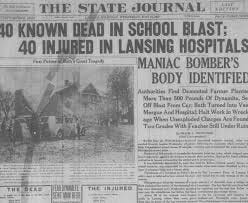A War Over Taxes Leaves 45 Dead
98 years ago this month, the unimaginable happened at the Bath Schoolhouse
America’s 1st Car-Bombing
On May 18, 1927, in Bath, Michigan, the children of farmers and merchants bounced into their new, stately brick school house. Like all schools, some were eager to learn and some were eager for recess. Thirty-eight would not survive the day.
A Town Split Over Taxes
Andrew Kehoe graduated from Michigan State College, School of Engineering. At some point, while working in St. Louis, Missouri, Kehoe suffered a head injury. By some accounts, when Kehoe woke up from the resulting coma, he was different. Angrier. Less impulse control. Both of which track for what we now know about traumatic brain injuries.
At fifty-five years old, Kehoe was operating a small farm and volunteering at the schoolhouse where he used his handy-man skills to maintain the property. In his capacity as treasurer for the school board, Kehoe became engaged by Superintendent Emory Huyck’s push to raise property taxes to support the district.
As an engineer and a farmer, Kehoe was skilled at explosives. In those days it wasn’t uncommon for farms to have “dynamite houses.” Farming by dynamite - stump removal, boulder break-up, well-digging - was common before machinery advancements. Kehoe had a stockpile. He was also a methodical planner.
“Suffering, unimaginable suffering. In fact, Kehoe’s motive was to kill the children, thus kill the entire community.”
At 8:45 in the morning ninety-eight years ago, Kehoe murdered his wife and set of an explosion at his farm. There would be no going back. In preparation, Kehoe had previously planted five hundred pounds of explosives at the school. After the two story building collapsed upon itself, Kehoe detonated the explosives stored in his truck. The second blast was targeted at the first responders and civilians rushing to the provide aid to the victims of the first blast. Kehoe’s suicide robbed the victims of justice.
Kehoe was suffering from an unchecked brain injury, which caused him to ruminate on his growing hatred of government, specifically a property tax increase.
“There was a war in the community over taxes.”
In Memory ~
Nellie Kehoe, wife of Andrew Kehoe
Arnold V. Bauerle, age 8, 3rd grade
Henry Bergan, age 14, 6th grade
Herman Bergan, age 11, 4th grade
Emilie M. Bromundt, age 11, 5th grade
Robert F. Bromundt, age 12, 5th grade
Floyd E. Burnett, age 12, 6th grade
Russell J. Chapman, age 8, 4th grade
F. Robert Cochran, age 8, 3rd grade
Ralph A. Cushman, age 7, 3rd grade
Earl E. Ewing, age 11, 6th grade
Katherine O. Foote, age 10, 6th grade
Marjorie Fritz, age 9, 4th grade
Carlyle W. Geisenhaver, age 9, 4th grade
George P. Hall, Jr., age 8, 3rd grade
Willa M. Hall, age 11, 5th grade
Iola I. Hart, age 12, 6th grade
Percy E. Hart, age 11, 3rd grade
Vivian O. Hart, age 8, 3rd grade
Blanche E. Harte, age 30, teacher
Gailand L. Harte, age 12, 6th grade
LaVere R. Harte, age 9, 4th grade
Stanley H. Harte, age 12, 6th grade
Francis O. Hoeppner, age 13, 6th grade
Cecial L. Hunter, age 13, 6th grade
Doris E. Johns, age 8, 3rd grade
Thelma I. MacDonald, age 8, 3rd grade
Clarence W. McFarren, age 13, 6th grade
J. Emerson Medcoff, age 8, 4th grade
Emma A. Nickols, age 13, 6th grade
Richard D. Richardson, age 12, 6th grade
Elsie M. Robb, age 12, 6th grade
Pauline M. Shirts, age 10, 5th grade
Hazel I. Weatherby, age 20, teacher
Elizabeth J. Witchell, age 10, 5th grade
Lucile J. Witchell, age 9, 5th grade
Harold L. Woodman, age 8, 3rd grade
George O. Zimmerman, age 10, 3rd grade
Lloyd Zimmerman, age 12, 5th grade
G. Cleo Clayton, age 8, 2nd grade
Emory E. Huyck, age 33, superintendent
Nelson McFarren, age 74, retired farmer
Glenn O. Smith, age 33, postmaster
Beatrice P. Gibbs, age 10, 4th grade
Richard A. Fritz, age 8, 3rd grade




